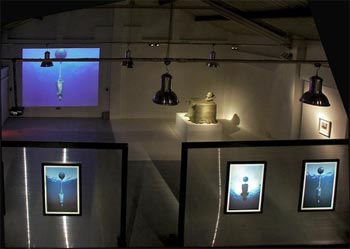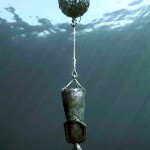The project space in Rome for Benedetto Pietromarchi’s exhibition was a medium sized warehouse, rising two stories. The exhibition space was divided by a pair of transparent screens on casters upon which four photographs were mounted. Behind these half walls were the two larger works: a video projection of an underwater scene and a nearly life-sized figurative clay sculpture.
Benedetto Pietromarchi has worked in a range of scales and media in his effort to connect our psyche to a site or structure. Pietromarchi has written about his interest in the psychological and philosophical aspects of architectural space (he sites Kant and Merleau-Ponty et al.) and a quest to make the ephemeral into form. In this exhibit, “It’s For Real”, the artist was successful in this regard precisely because he eschewed a single, specific narrative, allowing him to create an unconscious location–like a Philosopher–where each of us has to decide just what was “for real”. In “Equilibria”(2006) the central video work, the artist created a metaphysical stasis, or sense of what he calls “in-betweeness” to investigate our perceptions of existence and of a singular place. The scenario was made concrete by the sculptural subject placed, as our surrogate, at center stage.
The large, sumptuous, color video projection “Equilibria” (2006) captured a poetic undersea tug of war: a figurative statue hanging upside down from a glass fishnet float deep underwater. The entire tableaux hovered motionless mid-water, the netted float and ropes held in stasis by the perfectly counterweighted lead sculpture, both shifting only with the tide in a smooth, undulating movement. The submerged camera P.O.V. (also rising and falling smoothly) allowed the diffracted light of the sky above to be visible though the waters rippled surface, and the muffled sound of breather bubbles provided a background of aquatic sounds. The opposing vectors created both a paradox and a balance that metaphorically summed up the human condition. We are hurtling through space, surrounded by a vast universe of unimaginable dimension, yet our focus must often be limited to the immediate, physical challenges we face just to survive daily life: “sink or swim”. The dramatic “limbo” introduced an existential and a religious component with the same stroke. We saw ourselves held under tension and underwater so this “limbo” was not an effortless or playful one, it was at best an uneasy truce. A timeless ethos saturated the vast cathedral-like space with shifting rays of turquoise light. The symbolic inversion of the sculpture kept it from being too comfortable, its long garb and pose framed the work in a spiritual realm, loosely suggesting an archetypal religious figure. Even the net covered float would periodically reflect a flash of golden light–an annunciation of what was up above: Heaven, Salvation, or perhaps just the warm sun and another breath of air. In the opposite direction there was the fearful darkness of water leading to unknown, cold, airless depths.
To guard against this being simply didactic or illustrative, the artist puts us under the water too. Sure, we were standing in a project space but we are perceptually “in over our heads” looking up at the surface of the water and out into the blue oblivion. The image of the slow mesmerizing movement filled the viewer’s entire field of vision creating the sensation that you were bobbing weightlessly with each swell.
The medium sized color photos also entitled “Equilibria” (2006) hung so that you could see past them, indeed through the transparent corrugated wall that held them and into the video projection room. The photographs worked to concentrate the moment of suspension seen in the video by freezing it and afforded a different level of scrutiny than in the larger moving image. In the end though, the photos were overwhelmed by the video piece, the movement of which was essential in visualizing the balance that the artist had created.
The lone sculptural work in the exhibit, “Untitled (2007)” was a clay figure on a high plinth with a wide ruffled collar and a six-inch-long, pencil sharp nose. The gesture of the gray sculpture was convincing, if only implied, since in place of the body was a large cube shape. While the hands and the crazy clown-like ruffled collar were exceptionally detailed the melon head had a more stylized (creepy), carnival mask feel to it. The large scale and height lent a regal dominance to the figure, bringing the bald head up to the viewer’s eye level, which ended up drawing a little too much attention to the high collar (it actually had small buttresses in the back to hold it up) and the impossibly long nose. The resulting Pinocchio reference, without much distraction from the monochrome monotony of the single medium, caused the sculpture to feel like a heavy one-liner. The lying puppet’s story may have suited the artist’s interest in the architectonic–the elongating nose is a tempting structural manifestation of a mental activity: lying–Pietromarchi is more effective when he generates his own enigmatic narrative that the audience must decipher rather than simply pointing (intentionally or unintentionally) to an existing one.
On the wall next to the clay sculpture was another untitled work: a small framed photo collage of the clay sculpture sitting in a wooden “cart” from a newspaper photo (the cart was an early automobile according to the artist). That picture, like one of Max Ernst surreal collages, used the compelling curiosity surrounding the new “combination image” to suspend our disbelief and emerge much greater than the sum of its parts. It told stories as real as the old newspaper clipping but of a looser variety, with a coy humor which contrasted the the stiff, theatrical comedy of the larger work. It was well worth making the the clay sculpture just to use the photograph of it for this emotive collage.
Benedetto Pietromarchi makes images, environments and forms that quickly tune into and coerce our perceptions. His best works tangibly engage time and memory to illuminate some of our unconscious relationships to actual structures and to the structures of religion and politics. In doing so he makes visible how the intricate web of our existence can be effected by a seemingly simple shift in either perception or perspective.
- Installation view
- Benedetto Pietromarchi, Equilibria , ink jet on matte paper, 2006.
- Benedetto Pietromarchi, Untitled, plasticine oil clay, 2007.
"It's For Real" was on view January 24 - 30, 2007 at b-49> Project Space in Rome, Italy.
All images are courtesy of the artist and b-49> Project Space.







